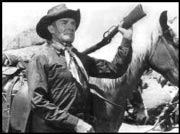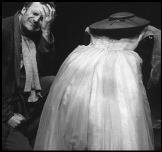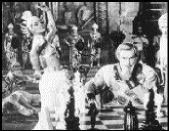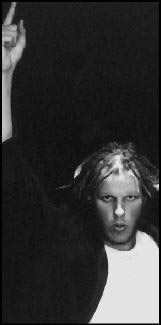RIDE LONESOME: CLASSIC WESTERNS FROM BUDD BOETTICHER
runs Sept. 28-Nov. 4 at Grand Illusion
THREE OF THE Westerns Oscar “Budd” Boetticher made starring Randolph Scott begin exactly the same, with the lone rider (Scott’s character, our hero) in a long shot, navigating barren rocks amid a breathtaking but lifeless landscape. They’re the same rocks, too, amid the empty Alabama Hills between the Sierras and Death Valley, where Boetticher and many other directors would return every few months to churn out what was, in effect, the same movie, sticking rigidly to a formula that fully satisfied the Hays Code. That constancy, depending on your tastes, is either a seductive comfort or a stiffening crutch.
Yet a film cult has grown around these midbudget pictures made through Scott’s producing partnership with Harry Joe Brown, and Boetticher’s fans credit him with unacknowledged brilliance. In his book Who the Devil Made It, Peter Bogdanovich calls Boetticher’s films “deceptively simple” and suggests their vigor and personal vision were achieved because B movies were made under the studio’s radar.
Watching them, though, it’s hard to see why they’ve garnered such a devoted following and inspired this six-title weekend series. Boetticher was certainly skilled at what he did, presenting the West as a hostile void tamed only by the resolute, ramrod-straight cowboy and his adherence to the mythic frontier code. In Saturday matinee material like 1957’s The Tall T (Oct. 6-7), the outlaws that capture Scott’s stagecoach are riven by their own interests and mutual suspicion, while the weak dandy—a little too handsome and well-fed—tries to save his own skin by ransoming his heiress bride. Scott’s sterling moral character leads even the snarling, cynical Richard Boone to admire him, and preserve him from the impulsive gun of his wild partner, Chink (a young and delightfully oily Henry Silva).
BOETTICHER WOULD later deride as “too complicated” his more nuanced ’57 film Decision at Sundown (Oct. 13-14), in which Scott has to face the truth about the compromised wife he’s trying to avenge. With 1959’s Ride Lonesome (Oct. 27-28) and 1960’s Comanche Station (Nov. 3-4), Boetticher has distilled his formula down to its most essential (and cheapest) elements, only slightly varying the plot outline from The Tall T: Seeking to free another ransomed woman, Scott must again maintain his personal honor while outwitting the villains who plan to kill him.
Throughout the series, screenwriter Burt Kennedy’s clich魲idden dialogue dwells on what a man needs—as in “A man kind of gets used to a thing,” “A man needs something he can call his own,” or “Some things a man can’t ride around.” Women, on the other hand, are treated as little more than a necessary plot nuisance. Universally weak, they can’t shoot, even though their breasts point like artillery. After being ravaged by miscegenating Indians, their lipstick, false eyelashes, and salon hairstyle remain intact. When kidnapped, they still do the cooking.
Boetticher’s celebration of rugged maleness and an honorable fight dominates even his first major picture, 1951’s Bullfighter and the Lady (which begins the series, Sept. 29-30), a semiautobiographical work based on the Ohio-born director’s experience as a matador in Mexico. In truth, the “Lady” (Joy Page) takes second place to the uncompelling affair of masculine respect and loyalty enjoyed between Robert Stack’s character and the great matador (Gilbert Roland) who teaches him in the ring.
Boetticher’s work is that of a competent journeyman—nothing groundbreaking (like John Ford’s work) or provocative (like High Noon or Shane), only a choice slice of a popular genre that, by whitewashing history, pandered to the chauvinism of the ’50s. If there’s a reason to see these movies today, perhaps it’s to better appreciate the later anti-westerns (Butch Cassidy or Little Big Man) that conspicuously rejected the simplistic morality of Boetticher’s era.








